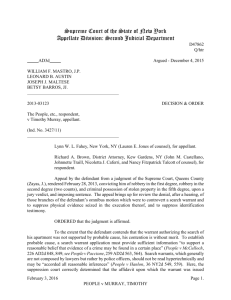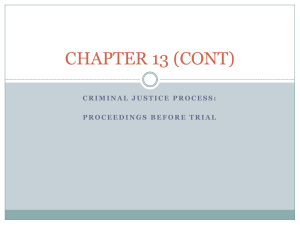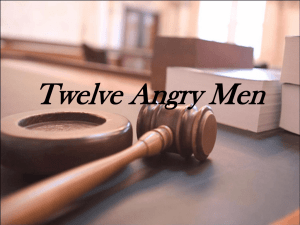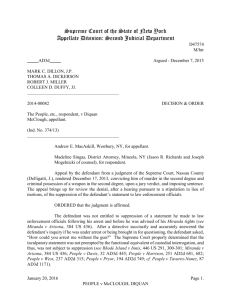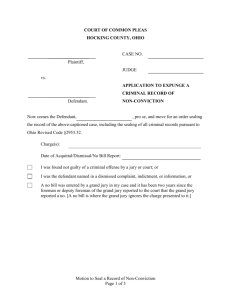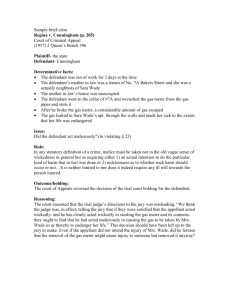People v Beasley - Kings County Criminal Bar Association
advertisement
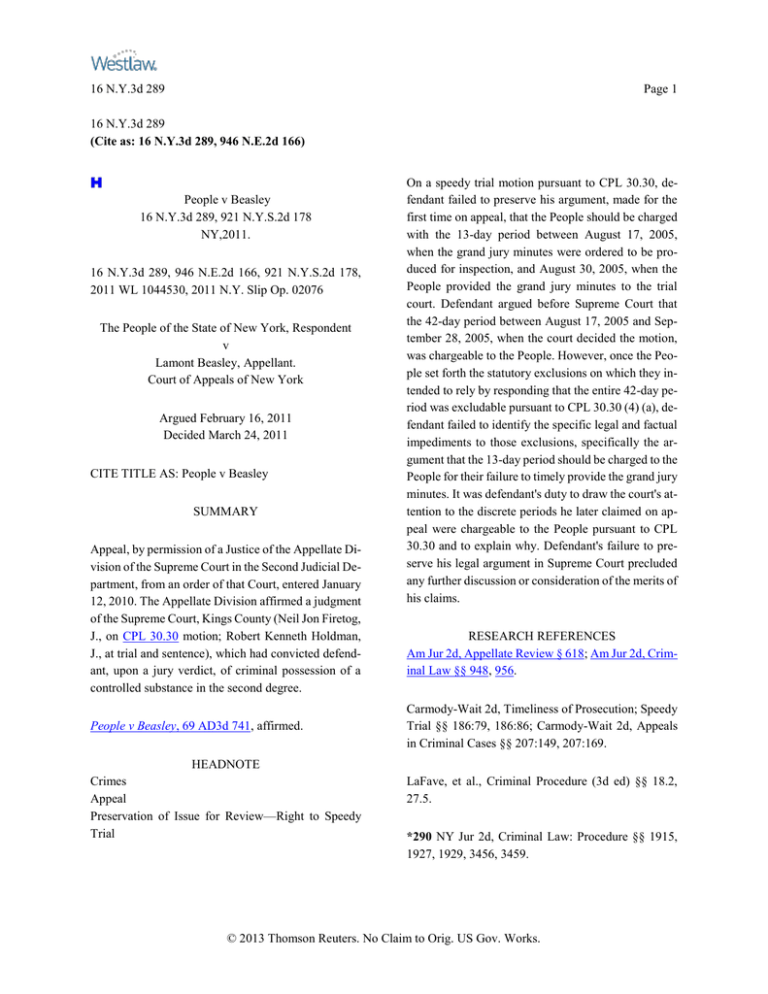
16 N.Y.3d 289 Page 1 16 N.Y.3d 289 (Cite as: 16 N.Y.3d 289, 946 N.E.2d 166) People v Beasley 16 N.Y.3d 289, 921 N.Y.S.2d 178 NY,2011. 16 N.Y.3d 289, 946 N.E.2d 166, 921 N.Y.S.2d 178, 2011 WL 1044530, 2011 N.Y. Slip Op. 02076 The People of the State of New York, Respondent v Lamont Beasley, Appellant. Court of Appeals of New York Argued February 16, 2011 Decided March 24, 2011 CITE TITLE AS: People v Beasley SUMMARY Appeal, by permission of a Justice of the Appellate Division of the Supreme Court in the Second Judicial Department, from an order of that Court, entered January 12, 2010. The Appellate Division affirmed a judgment of the Supreme Court, Kings County (Neil Jon Firetog, J., on CPL 30.30 motion; Robert Kenneth Holdman, J., at trial and sentence), which had convicted defendant, upon a jury verdict, of criminal possession of a controlled substance in the second degree. People v Beasley, 69 AD3d 741, affirmed. HEADNOTE Crimes Appeal Preservation of Issue for Review—Right to Speedy Trial On a speedy trial motion pursuant to CPL 30.30, defendant failed to preserve his argument, made for the first time on appeal, that the People should be charged with the 13-day period between August 17, 2005, when the grand jury minutes were ordered to be produced for inspection, and August 30, 2005, when the People provided the grand jury minutes to the trial court. Defendant argued before Supreme Court that the 42-day period between August 17, 2005 and September 28, 2005, when the court decided the motion, was chargeable to the People. However, once the People set forth the statutory exclusions on which they intended to rely by responding that the entire 42-day period was excludable pursuant to CPL 30.30 (4) (a), defendant failed to identify the specific legal and factual impediments to those exclusions, specifically the argument that the 13-day period should be charged to the People for their failure to timely provide the grand jury minutes. It was defendant's duty to draw the court's attention to the discrete periods he later claimed on appeal were chargeable to the People pursuant to CPL 30.30 and to explain why. Defendant's failure to preserve his legal argument in Supreme Court precluded any further discussion or consideration of the merits of his claims. RESEARCH REFERENCES Am Jur 2d, Appellate Review § 618; Am Jur 2d, Criminal Law §§ 948, 956. Carmody-Wait 2d, Timeliness of Prosecution; Speedy Trial §§ 186:79, 186:86; Carmody-Wait 2d, Appeals in Criminal Cases §§ 207:149, 207:169. LaFave, et al., Criminal Procedure (3d ed) §§ 18.2, 27.5. *290 NY Jur 2d, Criminal Law: Procedure §§ 1915, 1927, 1929, 3456, 3459. © 2013 Thomson Reuters. No Claim to Orig. US Gov. Works. 16 N.Y.3d 289 Page 2 16 N.Y.3d 289 (Cite as: 16 N.Y.3d 289, 946 N.E.2d 166) ANNOTATION REFERENCE See ALR Index under Appeal and Error; Speedy Trial. FIND SIMILAR CASES ON WESTLAW Database: NY-ORCS Query: appeal & preserv! /p speedy /2 trial /p exclusion POINTS OF COUNSEL Jeremy Gutman, New York City, for appellant. Lamont Beasley's conviction and sentence should be vacated, and the indictment dismissed, because the People were not ready for trial within the period mandated by CPL 30.30. (People v Berkowitz, 50 NY2d 333; People v Cortes, 80 NY2d 201; People v Stirrup, 91 NY2d 434; People v McKenna, 76 NY2d 59; People v England, 84 NY2d 1; People v Brewer, 63 AD3d 402; People v Liotta, 79 NY2d 841; People v Daniels, 217 AD2d 448; People v Meierdiercks, 68 NY2d 613; People v Anderson, 66 NY2d 529.) Charles J. Hynes, District Attorney, Brooklyn (Ann Bordley and Leonard Joblove of counsel), for respondent. Defendant's claim concerning the CPL 30.30 ruling is unpreserved and meritless. (People v Goode, 87 NY2d 1045; People v Luperon, 85 NY2d 71; People v Hawkins, 11 NY3d 484; People v Sinistaj, 67 NY2d 236; People v Osgood, 52 NY2d 37; People v Cortes, 80 NY2d 201; People v Kendzia, 64 NY2d 331; People v Carter, 91 NY2d 795; People v Vaughn, 36 AD3d 434, 552 US 1284; People v Goss, 87 NY2d 792.) OPINION OF THE COURT Ciparick, J. On May 5, 2005, defendant Lamont Beasley was arraigned on a felony complaint charging him with criminal possession of a controlled substance in the second degree and lesser offenses. The matter was presented to a grand jury and, on May 27, 2005, an indictment was filed and the People announced their readiness for trial. On June 15, 2005, defendant was arraigned on the indictment and Supreme Court adjourned the matter to August 17, 2005, ordering open file discovery and production of the grand jury minutes for inspection pursuant to defendant's motion to dismiss the indictment. On August 17, 2005, the People failed to produce the grand jury minutes and informed *291 the court that they would produce the minutes “off calendar.” Supreme Court adjourned the proceedings to September 28, 2005. The People provided the grand jury minutes to chambers on August 30, 2005. Supreme Court decided the motion on September 28, 2005. Subsequent adjournments ensued not relevant to this appeal and, on September 12, 2006, defendant moved pursuant to CPL 30.30 (1) (a) to dismiss the charges on the basis that the People had exceeded the statutory limit of six months (in this case, 184 days) in bringing the **2 matter to trial. The affirmation filed in support of the motion argued inter alia that, “[o]n August 17, 2005, the People represented the grand jury minutes will be provided off calendar and the matter was adjourned to September 28, 2005. The period of August 17, 2005 to September 28, 2005, a total of 42 days, are chargeable to the People.” The People in response argued that, pursuant to CPL 30.30 (4) (a), the 42-day period between August 17, 2005 and September 28, 2005, during which the decision on the sufficiency of the grand jury minutes was still pending, was excludable. Defendant did not file a reply, nor was there oral argument on the motion. Defendant never argued that the 42-day period should be broken down into smaller periods reflecting the pre and post production of the grand jury minutes. In fact, defendant made no argument at all refuting the People's contention that the entire period was excludable. Supreme Court denied the motion, charging the People with 173 days of delay, and the matter proceeded to trial. Defendant was convicted of criminal possession © 2013 Thomson Reuters. No Claim to Orig. US Gov. Works. 16 N.Y.3d 289 Page 3 16 N.Y.3d 289 (Cite as: 16 N.Y.3d 289, 946 N.E.2d 166) of a controlled substance in the second degree and sentenced as a second felony drug offender to 12 years in prison and five years of postrelease supervision. of those exclusions” (People v Goode, 87 NY2d 1045, 1047 [1996] [citations, internal quotation marks and brackets omitted]). A divided Appellate Division affirmed the judgment of conviction, finding that the entire 42-day period between August 17, 2005 and September 28, 2005 was excludable (People v Beasley, 69 AD3d 741 [2d Dept 2010]). The dissenting Justices concluded that the 13day period from August 17, 2005, the date set for open file discovery and production of the grand jury minutes, to August 30, 2005, the date the minutes were actually produced, should be chargeable to the People. The dissent noted that failure to provide grand jury minutes “[is] a direct, and virtually insurmountable, impediment to the trial's very commencement” (Beasley, 69 AD3d at 747, quoting People v McKenna, 76 NY2d 59, 64 [1990]). Thus the dissenting Justices would have added *292 13 days to the 173 found by Supreme Court for a total of 186 days, a clear speedy trial violation mandating dismissal of the indictment. A Justice of the Appellate Division granted defendant leave to appeal (14 NY3d 895 [2010]) and we now affirm, on different grounds. Here, defendant met his initial burden. However, once the People set forth the statutory exclusions on which they intended to rely, defendant failed to identify the specific legal and factual impediments to those exclusions, specifically the argument that the People should be charged with the 13 days between August 17th and August 30th for failing to timely provide the grand jury minutes. Because defendant failed to raise this argument before the Supreme Court, he has preserved no question of law for our review (see People v Luperon, 85 NY2d 71, 77 [1995]). On this appeal, defendant argues, for the very first time, that the People should be charged with the discrete 13-day period between August 17th and August 30th. This argument was not properly preserved at Supreme Court and therefore we cannot review it (seeCPL 470.05 [2]). The procedure for preserving an argument in a CPL 30.30 motion is well established. “A defendant seeking a speedy trial dismissal pursuant to CPL 30.30 meets his or her initial burden on the motion simply by alleging only that the prosecution failed to declare readiness within the statutorily prescribed time period. However, once the People **3 identify the statutory exclusions on which they intend to rely, the defendant preserves challenges to the People's reliance on those exclusions for appellate review by identifying any legal or factual impediments to the use Defendant argues that all the information the trial court required was contained in the People's affirmation, which stated that the grand jury minutes were not produced until August 30, 2005, and therefore, the trial court had all the information it needed to “remedy the problem and thereby avert reversible error” (id. at 78). This argument is unavailing. Nothing in the People's affirmation would have alerted the trial court thatdefendant*293 was claiming that the People should be charged with 13 days of postreadiness delay due to the untimely production of the grand jury minutes. It was defendant's duty, either in his initial submission or in a reply, to draw the court's attention to the discrete periods that he now claims should have been chargeable to the People pursuant to CPL 30.30 and to explain why. Not only did defendant fail to highlight the 13day period, he failed to offer any legal basis for his claim that the entire 42-day period was chargeable as postreadiness delay, or rebut in any way the People's contention that the 42-day period fell within one of the exemptions. Defense counsel's obligation to point out the legal or factual impediments to the People's arguments is a rule to be “adher[ed] to strict[ly]” (Goode, 87 NY2d at 1047). That the trial court has all the factual information before it is immaterial. “[I]t is defense counsel © 2013 Thomson Reuters. No Claim to Orig. US Gov. Works. 16 N.Y.3d 289 Page 4 16 N.Y.3d 289 (Cite as: 16 N.Y.3d 289, 946 N.E.2d 166) who is charged with the single-minded, zealous representation of the client and thus, of all the trial participants, it is defense counsel who best knows the argument to be advanced on the client's behalf” (People v Hawkins, 11 NY3d 484, 492 [2008] [reviewing claim of legal insufficiency]). Defendant's failure to preserve his legal argument in Supreme Court precludes any further discussion or consideration of the merits of his claims. Accordingly, the order of the Appellate Division should be affirmed.**4 PEOPLE v BEASLEY 16 N.Y.3d 289, 946 N.E.2d 166578921 1786022011 WL 10445309992011 N.Y. 020764603, 946 N.E.2d 166578921 1786022011 WL 10445309992011 N.Y. 020764603, 946 N.E.2d 166578921 1786022011 WL 10445309992011 N.Y. 020764603, 946 N.E.2d 166578921 1786022011 WL 10445309992011 N.Y. 020764603 END OF DOCUMENT Smith, J. (concurring). I think the preservation here was adequate. Defendant argued that 42 days of time were chargeable to the People because of their failure to furnish the grand jury minutes promptly; that should be read as encompassing an argument that the first 13 days of that time were so chargeable for the exact same reason. It is not fair or realistic to insist that a defense lawyer follow arguments of this kind with a diminuendo sequence (“all three weeks are chargeable to the People, but if not the first two weeks are, and if not that the first week, and if not that the first three days . . .”). This affirmance on preservation grounds will only encourage prosecutors in their already well-established tendency to pounce on every arguable imperfection in a defense lawyer's argument as a barrier to deciding a case on the merits. I would reach the merits and would affirm the Appellate Division's order, essentially for the reasons stated by the Appellate Division majority. *294 Chief Judge Lippman and Judges Graffeo, Read, Pigott and Jones concur with Judge Ciparick; Judge Smith concurs in result in a separate opinion. Order affirmed. Copr. (c) 2013, Secretary of State, State of New York NY,2011. © 2013 Thomson Reuters. No Claim to Orig. US Gov. Works. N.Y.S.2d Slip Op. N.Y.S.2d Slip Op. N.Y.S.2d Slip Op. N.Y.S.2d Slip Op.
